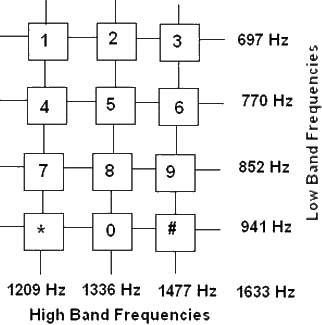Tone Dialing
In tone dialing type of telephones, pressing the digit keys causes the dial network to produce specific tones that the central office recognizes and decodes. This type of telephone is also called touch-tone service telephone. It contains push buttons and tone generating circuits, instead of a rotary dial.
When a button is pressed, a signal of two frequencies is generated and is transmitted to the central switching office to identify the key. In these frequencies, one is in the low frequency band and the other is in the high frequency band. Thus by pressing the key 5 transmits two signals, one at the frequency 770 Hz and the other at the frequency 1336 Hz. These frequencies are translated into a series of pulses similar to those made by the rotary dial.
Basis for the selection of these frequencies is such that there is no possibility that the harmonics of one set of frequencies is mistaken for another set of frequencies. If a fourth band of high frequency, 1633 Hz, is provided then 16 keys can be accommodated which are used for special applications. These frequencies are indicated by the intersection of the frequency lines in the tone matrix as shown in the figure.

